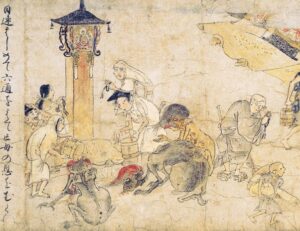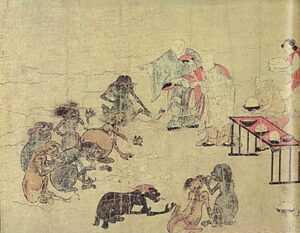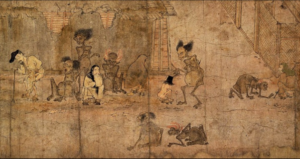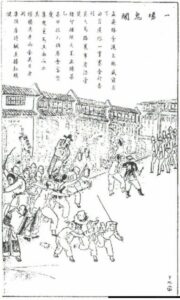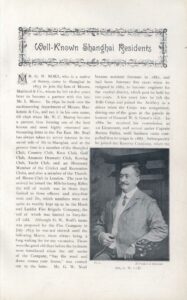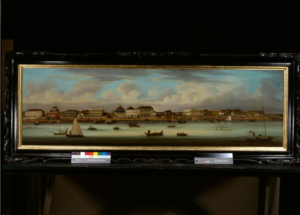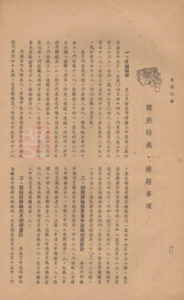Since its first encounter. Western opinion has been largely negative on the practice of Fengshui. Ernest J. Eitel in 1873 characterises it as ‘the blind gropings of the Chinese mind’, which one has ‘to overthrow’ to modernise a state.’ (1) Similarly, Edwin Dukes characterises it as a contradictory, ‘overbearing tyrant’ which will eventually be worn down and replaced by western thought and technology. (2) Beyond calling it irrational, some western scholars even characterised it as actively malevolent, posing ‘real danger and persecution’ to the missionaries. (3) By the early 20th century however, western scholarship had shifted a little, to include a few more sympathetic voices to geomancy’s case, with writers such as L.C Porter and Joseph Needham seeking to ground it in philosophy and science respectively, rather than dismissing it immediately as superstitious nonsense. (4)
This more sympathetic tone can be seen in US Congressmen Victor Murdock’s 1920 book China the Mysterious and Marvellous, which was a travel account of China and its spiritual and cultural practices. He similarly grounds Fengshui as a collected knowledge gathered over ’40 decades, ‘the science of knowing what is an auspicious place’ and an ‘ancient and revered custom’. (5) While he argues that the new Republic should work to de-prioritise Fengshui in favour of western progressive ideas, he argues patience towards the Chinese population as asking them to change this custom is akin to asking Westerners to change something fundamental like the days of the week. (6)
What distinguishes him from both Eitel and Dukes however, is that he doesn’t just see Fengshui as a spiritual practice used by the Chinese commoners, but a wider characteristic and emblem to describe China as a whole. In his concluding remarks about his experience travelling through the new Republic of China he notes that ‘The Feng-shui is right…it is here, the Chinese believe in it, and it is working for the Republic.’ (7) This statement is striking for two reasons, firstly it is contradictory to the Republic’s state on the moment writing and their attitude towards Fengshui. Secondly, it highlights the conflation of two conceptions of Fengshui in Western eyes, Fengshui as something to be cultivated, and Fengshui as an omnipresent entity.
In line with Murdock’s earlier remarks in his work – that Fengshui was a longstanding, ingrained custom that the Republic’s ‘spirit of progress’ was helping to loosen its grip – the ROC policy towards geomancy was suppression. (8) The new ruling class of modern educated urban elites saw breaking popular superstition as a necessary condition to transform China and to claim the identity of a modern nation. The establishment of foreign universities and the growing interest in science led to the rise of anti-religious sentiment in the 1920s, calling for the end of rituals of popular religion. (9) Within the decade of Murdock writing this, the government produced the ‘Procedure for the Abolition of the Occupations of Divination, Astrology, Physiognomy and Palmistry, Magic and Geomancy (1929). In this period then, the Chinese Officials and Western commentators seems to be working in tandem to undermine Fengshui. Yet despite this, Murdock still chose to characterise the Republic’s success, and future, on the existence of Fengshui.
Beyond basing their success on something that the government was actively trying to distance themselves from, the basis he provides to evidence that Fengshui was working in their favour seems spurious. Given that by the 1920s the Communist party was getting more of a foothold in China, and a year prior to publishing the Republic had to contend with the May Fourth movement, luck and good Fengshui are interesting qualities to characterise the new regime. He claims that the war with Japan and the Boxer uprising were fortunate events, both the workings of Fengshui which helped secure the success of the Republic. Yuan Shikai’s attempt to restore monarchy was permanently thwarted when fengshui ‘operated’ , causing his death (10). In the narrative Murdock describes, Fengshui isn’t generated or cultivated by the events, but rather it implies it cultivates the events to the fortune of the Republic. Murdock, therefore, positions this force as a spirit or omnipresent entity rather than a practice.
Both Dukes and Eitel explain, mostly disbelievingly, that Fengshui is something that can be disrupted or altered by actions, that someone can cultivate good Fengshui for themselves, or bad Fengshui for others, through distinct actions or spatial arrangements. Even beyond western interpretation, wider scholarship seems to characterise Fengshui as a more individualistic, ego-centred practice, not something working for and against a large collective such as a state. (11) Presenting it in such a way then suggests Murdock wasn’t just reviewing or critiquing Fengshui but utilising it for a distinct purpose. Murdock was working under Woodrow Wilson, whose presidency had been characterised as deploying ‘missionary diplomacy’. (12) He saw spreading Christianity and democratic ideals as his role in China, and as such worked extensively in his terms to cultivate a good relationship with the nation. As mentioned above, the educated elites were responsive to this agenda, drawing on British and American models for governance, and in turn utilised this relationship to put pressure on Wilson to acknowledge the new regime, and securing his support in relation to their demand to have the Shandong province returned to them. (13) Murdock’s representation of the Republic, endowed with good Fengshui and somehow destined to survive, is in line with both the Republic’s and United State’s interest. By characterising a regime that had been more responsive to Western ideas and technologies as inherently lucky and auspicious, Murdock was protecting American interests. Therefore, it could be argued, in the same way that Western observers like Dukes and Eitel argued that Chinese locals used Fengshui as a way to oppose foreign influence, that Murdock saw Fengshui as a tool, and popular selling point, to bolster support and confidence around the more Western-minded Republic of China.
(1) Ernest John Eitel, Feng Shui or the Rudiments of Natural Science in China (1873), pp.49-50
(2) Edwin Joshua Dukes. Everyday Life in China: Or, Scenes Along River and Road in Fuh-Kien. Religious Tract Society, 1885. IA Ch VIII Feng-shui: The Biggest of All Bugbears pp145-159, p.159
(3) James E. Mills, “Western responses to feng shui.” Middle states geographer 32 (1999): 71-77, p. 72
(4) Mills, ‘Western responses’, p.73
(5) Victor Murdock, China the mysterious and marvellous. (Fleming H. Revell Company, 1920), p.134, p.137
(6) Murdock, China the mysterious, p.138
(7) Murdock, China the mysterious, p.307
(8) Murdock, China the mysterious, p.138
(9) Ole Bruun. Fengshui in China: Geomantic divination between state orthodoxy and popular religion. (University of Hawaii Press, 2003), pp.72-78
(10) Murdock, China the mysterious, p.307
(11) Brunn, Fengshui in Chin, p.15
(12) Eugene P. Trani, “Woodrow Wilson, China, and the Missionaries, 1913—1921.” Journal of Presbyterian History (1962-1985) 49. 4 (1971), pp. 328-351,
(13) Trani, “Woodrow Wilson”, , p.335, pp.347-351

